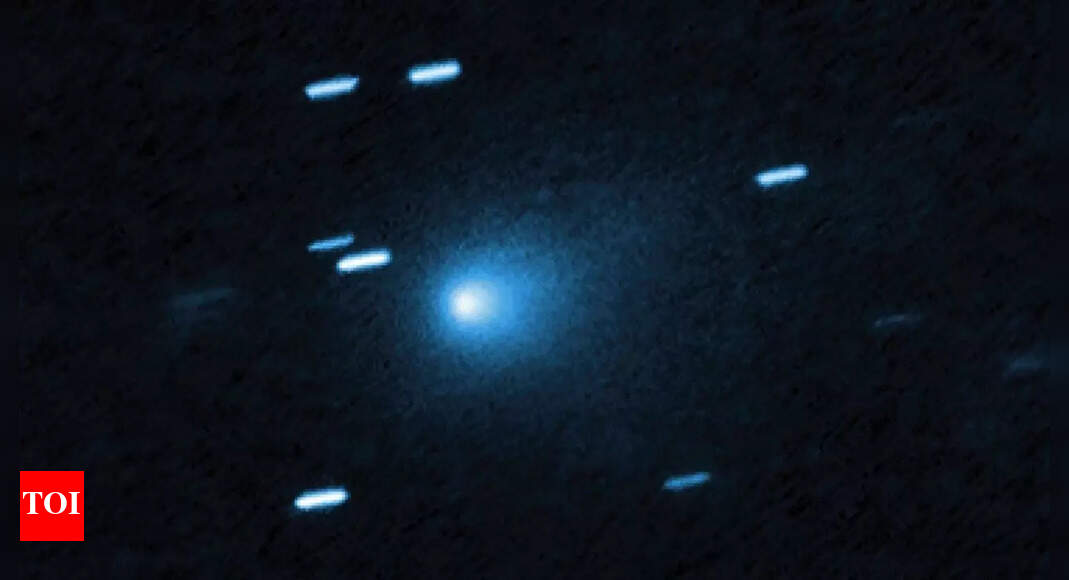
The interstellar object 3I/ATLAS has captured global attention not only for its unusual trajectory through space but also for a mysterious pulse signal reportedly linked to it. Scientists are investigating this strange sequence, which appears to follow the Fibonacci pattern, which is a mathematical sequence commonly found in DNA, plants, and galaxies. Detected at a frequency associated with interstellar communication, the signal’s precision and repetition have led researchers to question whether it could represent an intelligent transmission from beyond our Solar System. While experts urge caution and await confirmation, the discovery has reignited global curiosity about extraterrestrial life and the potential for meaningful signals from interstellar objects like 3I/ATLAS, making it one of the most intriguing space mysteries of 2025.
3I/ATLAS detected sending stable 1420 MHz signal across space
According to a post shared on X (formerly Twitter), researchers have picked up a stable pulse sequence of 8 • 13 • 8 • 5 • 13 • 8 at a frequency of 1420 MHz. This frequency is also known as the hydrogen line, commonly referred to as the interstellar calling channel in SETI (Search for Extraterrestrial Intelligence) studies.What makes this signal particularly fascinating is its stability and precision. It was detected simultaneously across a distance of 15,000 kilometres, ruling out any instrument or data transmission error. Scientists say the pulses appear to be deliberate and intelligent, as they remain unaffected by the object’s rotation, which is unusual for natural cosmic sources.The decoded message reportedly reads: “Observe. Prepare. Understand. The Gate Awaits.”If verified, this would represent the first-ever deliberate interstellar communication from an object entering our Solar System, marking a potentially historic moment in human scientific exploration.
Fibonacci pattern in 3I/ATLAS signal raises questions about its source
The Fibonacci sequence is one of the most important patterns in mathematics and nature. It describes a series of numbers where each value is the sum of the two preceding ones. This sequence is observed in DNA structures, galaxy spirals, sunflowers, seashells, and even in the branching of trees.The presence of a Fibonacci-like signal from 3I/ATLAS has fuelled speculation that the transmission could be of intelligent or artificial origin, given how frequently this sequence appears in both natural design and advanced algorithms. Earlier, filmmaker and researcher David Sereda, known for working with MIT physicist Bogdan C. Maglich on nuclear fusion research, also reported unusual light emissions from 3I/ATLAS on October 13, 2025. Sereda noted that these emissions appeared to follow a Fibonacci rhythm, coinciding with the 108th anniversary of the Miracle of the Sun at Fátima in Portugal.Despite the excitement, scientists have urged the public to remain cautious. Many unverified claims circulate online, and researchers are working to confirm whether this signal is genuine or caused by natural or instrumental interference.
Understanding the rare interstellar comet: 3I/ATLAS
The interstellar object 3I/ATLAS was first spotted in July 2025 using the Asteroid Terrestrial-impact Last Alert System (ATLAS) in Hawaii. From the beginning, astronomers realised that 3I/ATLAS was not an ordinary comet. It was travelling much faster than any Solar System comet and followed a hyperbolic orbit, meaning it was not bound by the Sun’s gravity.Its interstellar origin was later confirmed by several major observatories. Theoretical physicist Michio Kaku described it as a “mystery interstellar object” passing through the Solar System on a one-time journey. Scientists believe it may have been ejected from another star system after a close encounter with a massive planet.Unlike comets that orbit the Sun repeatedly, 3I/ATLAS is a one-time visitor that will never return once it exits our Solar System.
How close will 3I/ATLAS come to Earth
Although it has generated considerable excitement, experts confirm that 3I/ATLAS poses no danger to Earth. On 29 October 2025, the comet made its closest approach, coming within 1.8 astronomical units (about 167 million miles) of our planet. That is nearly twice the distance between Earth and the Sun, so there is no cause for concern.This close pass gives astronomers a valuable chance to study the object in detail using space and ground-based telescopes. The data gathered will help scientists better understand its composition, behaviour, and origin.
When and where can you see 3I/ATLAS
Currently, 3I/ATLAS cannot be seen with the naked eye. Its brightness level of 12 to 14 magnitude means it requires a telescope of at least 8 inches (200mm aperture) for observation.At the moment, the comet is hidden behind the Sun in a phase known as solar conjunction, which makes viewing impossible. However, astronomers expect it to reappear in December 2025, when it will become visible from the Northern Hemisphere. Under dark, clear skies, observers using telescopes will be able to see its glowing coma and long tail as it moves away from the Sun.Also Read | Is 3I/ATLAS more than a comet? This rare interstellar visitor might become Earth’s silent protector from asteroid threats








